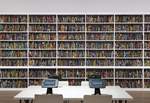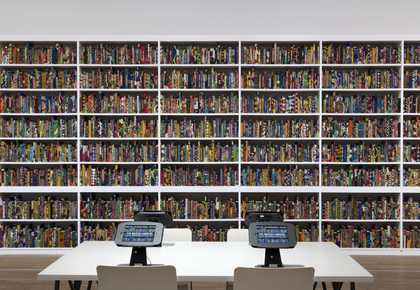You will need
- Thick paper that would be good for covering a book
- Tracing paper and/or thin card
- Scissors
- Masking tape
- Colouring materials: pastels, coloured pens, paint
- Books to cover (temporarily)


You will need
Your students don’t need to know anything about an artwork or artist to start exploring it.
Use these quick group activities to build their confidence and curiosity in sharing their first responses to the artwork. Some artworks they might like straight away, some they might not.
Discovering art can be new, exciting and sometimes confusing. There are no right or wrong ways to respond!
In pairs or as a group, take it in turns to imagine the artworks answering these questions and telling their story.
In pairs or as a group, use your body to respond to the artwork.
Yinka Shonibare’s installation The British Library 2014 explores perspectives on immigration. Made of 6,328 books, the work shares histories through their spines. Many of these books carry the names of second-generation immigrants to Britain, both people who are celebrated and those lesser known, alongside the names of people who have also opposed immigration. Shonibare leaves some spines blank to make visible how the ongoing, hard-fought history of immigration continues to be created, spoken about and written.
The books are covered in a material associated with African textiles and crafts. There are many different textile traditions across Africa, but the material used in The British Library is called Dutch wax print. Shonibare uses this because it holds its own complicated story of colonisation and exploitation. As such, this piece brings together many different viewpoints on the subject of immigration, evoking the sense of a gathering of different individuals, experiences and ideas.
Yinka Shonibare’s British-Nigerian dual identity is the starting point for much of his work. He was born in London and grew up in Lagos, Nigeria before coming back to study art in the UK. He describes himself as ‘a postcolonial hybrid’ and the fabrics he uses are symbols of this multicultural identity.
Yinka Shonibare prompts us to think about cultural hybridity through his artwork. This activity invites you to create your own pattern or ‘fabric’ with which to transform a book in your classroom or library, creating a collaborative artwork that represents you.
Adapt
Create a cover for a book by choosing a simple shape and making a repeating pattern with it onto some paper.
You could do this by drawing, stamping, using pre-cut shapes, using a stencil, or anything else.
Add colour to your patterns, then create a display of everyone’s book covers.
3. Now add colour. Think about how you can do this responding to the new shapes and spaces you have created and pay attention to how this changes your shapes from familiar things into a more abstract pattern.
4. You can think about giving yourself rules, such as using only 3 colours, or repeating the same colour in each recurring shape. Through this process your original items might completely disappear, or you might still see the suggestion of them in your pattern.
5. Now carefully cover your book. You will need to do this without damaging it. The book needs to be smaller than the patterned paper. Open the book out flat and with the patterned side face down on the table, fold the overlapping edges onto the front and back inside covers; you might want to make small cuts at the top of the paper on either side of the spine before you make the folds. Use small pieces of masking tape to hold the cover in place (this is temporary).
6. Look back at the image of The British Library – imagine your book joining with the books by these other writers.
Whose ideas do you want to agree with?
Whose do you want to oppose?
Why?
7. At the end of your lesson, bring all of your pieces together in a collective artwork – this is an installation. This could be on a shelf in your classroom, an entire library or simply a pile on a table. Find each other’s shapes and celebrate the artwork you’ve just made!
What have you learned by experimenting with pattern, colour and drawing?
What do the shape-objects you included represent to you?
Extend
Part of the power of The British Library is that it transforms something familiar – books on a shelf – in a way that makes us stop and think.
Invite your students to discuss with a partner or as a group, how your class intervention has encouraged you to stop and think? Does your work raise the same questions as The British Library, or has it done something else?
Have a conversation about what the patterns hold – what stories they tell about your personalities, glimpses into your life experiences, your thoughts and ideas. If you could add a new book title – real or imagined – what would it be?
As a further lesson or as homework, suggest your students research something about their own family story: how did we arrive to where we are today? This might include places, traditions, transformations, journeys or actually staying in one place over time.
Making art is a powerful way to learn new skills, explore ideas and express ourselves creatively. Encourage your students to discover new materials, techniques and methods inspired by great artists at Tate.
2. Explore (10 minutes)
3. Make (30 minutes)